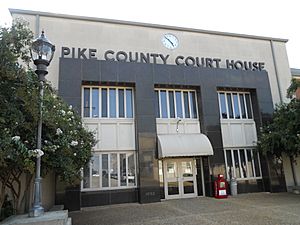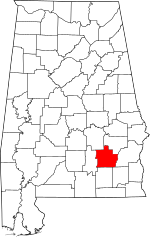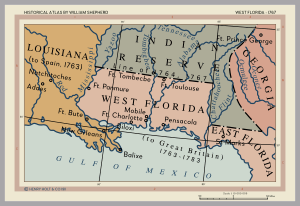Pike County, Alabama facts for kids
Quick facts for kids
Pike County
|
||
|---|---|---|

Pike County Courthouse in Troy
|
||
|
||

Location within the U.S. state of Alabama
|
||
 Alabama's location within the U.S. |
||
| Country | ||
| State | ||
| Founded | December 17, 1821 | |
| Named for | Zebulon Pike | |
| Seat | Troy | |
| Largest city | Troy | |
| Area | ||
| • Total | 673 sq mi (1,740 km2) | |
| • Land | 672 sq mi (1,740 km2) | |
| • Water | 0.9 sq mi (2 km2) 0.1% | |
| Population
(2020)
|
||
| • Total | 33,009 | |
| • Estimate
(2023)
|
33,137 |
|
| • Density | 49.05/sq mi (18.937/km2) | |
| Time zone | UTC−6 (Central) | |
| • Summer (DST) | UTC−5 (CDT) | |
| Congressional district | 2nd | |
|
||
Pike County is a county located in the state of Alabama, USA. In 2020, about 33,009 people lived there. The main city and government center is Troy. The county is named after General Zebulon Pike. He was an explorer from New Jersey who led a trip to southern Colorado in 1806. During his journey, he discovered Pikes Peak.
Pike County is part of the Troy, Alabama, Micropolitan Statistical Area. This means it's a region with a city (Troy) and nearby areas that are closely connected.
Contents
History of Pike County
The land that is now Pike County was home to Native Americans for thousands of years. Different European countries, like Spain, France, and Great Britain, all claimed this area. But most European settlers stayed near the coast. Very few lived inland.
In 1763, after the French and Indian War, France gave its land claims to the British. The British then made a rule, the Royal Proclamation of 1763. This rule said that British people could not settle in this area. It was set aside for the native peoples.

Between 1767 and 1783, Pike County was part of a British colony called British West Florida. Still, most white settlers lived along the coast or near the Mississippi River. After the American colonists won the American Revolutionary War, the British gave the land to Spain. Spain was an ally of the Americans.
However, both Spain and the United States claimed the region. This changed when Spain gave up its claims to the land north of the 31st parallel in 1795. This line is now the border between Alabama and Florida. The United States then created the Mississippi Territory in this area.
In 1817, the Mississippi Territory was split. The western part became the State of Mississippi. The rest became the State of Alabama in 1819. Soon after, Alabama was divided into counties. Pike County is one of the oldest counties in Alabama. It was officially created on December 17, 1821.
At first, Pike County was very large. It included parts of what are now Crenshaw, Montgomery, Macon, Bullock, and Barbour counties. It even stretched all the way to the Chattahoochee River in the east.
Geography and Transportation
Pike County covers about 673 square miles. Most of this area, about 672 square miles, is land. Only a small part, about 0.9 square miles, is water.
Main Roads in Pike County
Several important highways run through Pike County, making it easy to travel. These include:
 U.S. Highway 29
U.S. Highway 29 U.S. Highway 231
U.S. Highway 231 State Route 10
State Route 10 State Route 87
State Route 87 State Route 93
State Route 93 State Route 125
State Route 125 State Route 130
State Route 130 State Route 167
State Route 167 State Route 201
State Route 201 State Route 223
State Route 223
Local Transportation
The Pike Area Transit System (PATS) helps people get around. It offers a "demand-response" service. This means you can call and arrange for a ride when you need one.
Neighboring Counties
Pike County shares borders with several other counties:
- Bullock County (to the northeast)
- Barbour County (to the east)
- Dale County (to the southeast)
- Coffee County (to the south)
- Crenshaw County (to the west)
- Montgomery County (to the northwest)
People of Pike County
The population of Pike County has changed over time. Here's a quick look at how many people have lived there:
| Historical population | |||
|---|---|---|---|
| Census | Pop. | %± | |
| 1830 | 7,108 | — | |
| 1840 | 10,108 | 42.2% | |
| 1850 | 15,920 | 57.5% | |
| 1860 | 24,435 | 53.5% | |
| 1870 | 17,423 | −28.7% | |
| 1880 | 20,640 | 18.5% | |
| 1890 | 24,423 | 18.3% | |
| 1900 | 29,172 | 19.4% | |
| 1910 | 30,815 | 5.6% | |
| 1920 | 31,631 | 2.6% | |
| 1930 | 32,240 | 1.9% | |
| 1940 | 32,493 | 0.8% | |
| 1950 | 30,608 | −5.8% | |
| 1960 | 25,987 | −15.1% | |
| 1970 | 25,038 | −3.7% | |
| 1980 | 28,050 | 12.0% | |
| 1990 | 27,595 | −1.6% | |
| 2000 | 29,605 | 7.3% | |
| 2010 | 32,899 | 11.1% | |
| 2020 | 33,009 | 0.3% | |
| 2023 (est.) | 33,137 | 0.7% | |
| U.S. Decennial Census 1790–1960 1900–1990 1990–2000 2010–2020 |
|||
2020 Census Information
In 2020, there were 33,009 people living in Pike County. There were 11,601 households and 6,422 families.
The population included people from many different backgrounds:
| Race / Ethnicity (NH = Not Hispanic) | Pop 2000 | Pop 2010 | Pop 2020 | % 2000 | % 2010 | % 2020 |
|---|---|---|---|---|---|---|
| White (NH) | 17,790 | 18,887 | 18,036 | 60.09% | 57.41% | 54.64% |
| Black or African American (NH) | 10,766 | 11,990 | 12,068 | 36.37% | 36.44% | 36.56% |
| Native American or Alaska Native (NH) | 190 | 185 | 169 | 0.64% | 0.56% | 0.51% |
| Asian (NH) | 105 | 645 | 577 | 0.35% | 1.96% | 1.75% |
| Pacific Islander (NH) | 5 | 6 | 9 | 0.02% | 0.02% | 0.03% |
| Other race (NH) | 25 | 14 | 117 | 0.08% | 0.04% | 0.35% |
| Mixed race or Multiracial (NH) | 359 | 442 | 1,128 | 1.21% | 1.34% | 3.42% |
| Hispanic or Latino (any race) | 365 | 730 | 905 | 1.23% | 2.22% | 2.74% |
| Total | 29,605 | 32,899 | 33,009 | 100.00% | 100.00% | 100.00% |
2010 Census Information
In 2010, Pike County had 32,899 people. The population density was about 49 people per square mile.
- About 58.2% of the people were White.
- About 36.6% were Black or African American.
- About 2.0% were Asian.
- About 2.2% of the population were Hispanic or Latino.
The average age of people in the county was 31.4 years old. About 20.3% of the population was under 18. About 21.2% were between 18 and 24.
The average income for a household was $29,181. For families, it was $41,570. About 28.6% of the people lived below the poverty line.
Communities in Pike County
Pike County has several cities, towns, and smaller communities.
Cities
Towns
Unincorporated Communities
These are smaller places that are not officially cities or towns.
- China Grove
- Curry
- Henderson
- Jonesville
- Josie
- Kent
- Needmore
- Orion
- Pronto
- Saco
- Shady Grove
- Shiloh
- Spring Hill
- Tennille
Notable People from Pike County
- John Lewis (1940–2020) was a very important African-American civil rights leader. He also served as a U.S. Congressman from 1987 to 2020.
See also
 In Spanish: Condado de Pike (Alabama) para niños
In Spanish: Condado de Pike (Alabama) para niños


